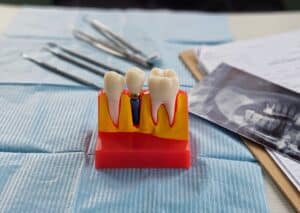Dry mouth, also called xerostomia (zero-STOW-me-uh), results from an inadequate flow of saliva. For people who suffer from this irritating and often destructive condition, there are two approaches that will address the condition artificial saliva and saliva stimulators. We recommend you review this article and then discuss your options with your dentist. If you take proactive action, your dry mouth problem may have a solution.
What is dry mouth?
Dry mouth, also called xerostomia (zero-STOW-me-uh), results from an inadequate flow of saliva. Drying irritates the soft tissues in the mouth, which can make them inflamed and more susceptible to infection. Severe dry mouth can promote the growth of harmful organisms. Without the cleansing and shielding effects of adequate saliva flow, tooth decay and periodontal (gum) disease become much more common. Constant dryness and the lack of protection provided by saliva contribute to bad breath. Dry mouth also causes full dentures to become less comfortable because there is no thin film of saliva to help them adhere properly to oral tissues.
Why would someone use artificial saliva?
Saliva coats and lubricates tissues in the mouth. It helps cleanse the mouth and begins the digestive process as we chew. When the saliva glands do not produce enough saliva, the mouth becomes dry. Although artificial saliva is not a perfect substitute for natural saliva (which is very complex physically and chemically), it doeswhen used regularlyhelp moisten the oral tissues, relieving the discomfort caused by dry mouth. Speaking, chewing and swallowing are made easier when the mouth is moist. You may need to ask your pharmacist for the product. Artificial saliva does not require a prescription, but it can be difficult to find on store shelves.
How is artificial saliva different from real saliva?
Although more than 99 percent of saliva is water, saliva also contains buffering agents, enzymes and minerals that keep teeth strong and play a crucial role in maintaining a healthy environment in the mouth. Artificial salivas normally contain a mixture of buffering agents, cellulose derivatives (to increase stickiness and moistening ability) and flavoring agents (such as sorbitol). However, they do not contain the digestive and antibacterial enzymes and other proteins or minerals present in real saliva. Research is underway to try and develop artificial salivas that more closely mimic natural saliva.
How often is artificial saliva used?
It can be used as often as needed, and generally comes in lozenges or a spray. Saliva substitutes are quickly swallowed and, therefore, the moistening and lubricating action has limited duration and repeat applications may be needed. Although saliva substitutes will not cure dry mouth, they can provide temporary relief of some symptoms.
What are saliva stimulators?
A saliva stimulant increases the natural production of saliva. The most efficient way to stimulate salivary flow is chewing, according to the American Dental Association, because it causes muscles to compress the salivary glands and release saliva; that’s why chewing your food well is so important. Chewing gum may help increase saliva production, but note that the ADA recommends sugarless brands. There are also several prescription drugs available that will stimulate saliva production. Talk to your dentist about your options.
Source: American Dental Association (ada.org)


